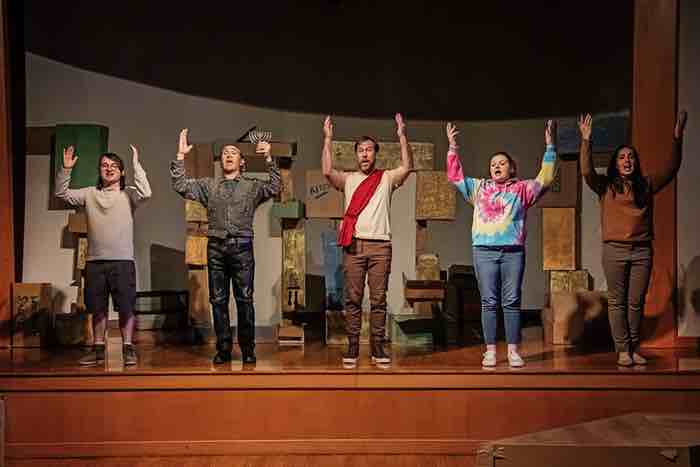
The little children sat, laid on or snuggled with the pillows that were wisely placed on the floor of the Stonehill Auditorium at the Jewish Community Center. The kids and their relatives were there to watch and sometimes participate in the world premiere of A Light in the Night: A Hanukkah Play. The 45-minute play with music was written by local writers Les and Elana Hunter.
Playwright and theater historian Dr. Les Hunter, who is an associate professor of English at Baldwin Wallace University, where he received the 2019 Bechberger Award for Human Development, is noted for a writing with an emphasis on shedding new light on emerging problems of selfhood. The coauthor is his wife Elena, who is a counselor.
The theme is not only the Jewish holiday commemorating the defeat of evil forces of old by the Maccabees, but the facing fear and being brave.
The plot centers on Judy and her family, who are moving across town. It’s the first night of Chanukah, and Mom and Dad forgot to pack the box with the menorah. Judy rides her bike back to the old house to search for the candelabra. When she finds it, she discovers that not only does the Shammes (the candle that is used to light the others) has the ability to talk but something has gone wrong. The evil forces have to be defeated once again or there will be no holiday. Judy and Shammes are responsible for fixing the problem or there will be no reason to celebrate.
As in all good melodramatic tales, the good guys find a way to win, much to the glee of the tykes watching this epic tale. Mazel tov to Shammes and Judy!
Observing various children during the presentation was an educational experience. Some were totally involved, singing when they were instructed to do so. Others jumped around when the cast danced. Still others were passive. It appeared that this offering was probably best for five to eight year olds. The older children in the main did not verbally participate and seemed uncomfortable when encouraged to participate. The very little children didn’t seem to know what was going on and there was not enough action and slapstick to hold their attention.
As is, there may have been too much talking and not enough action in the script. In addition, the use of Yiddish was over the heads of the children, even though all terms are defined verbally or on the screen which flashed the play’s dialogue. Most of them were not of reading age, and even for those that were, having them pay attention to both the screen and the dialogue seemed cut down on reactions. A little rewriting and some stage activity should take care of the problems.
The Tailspinner cast, under the direction of Margi Zitelli, was quite good, but lacked some opportunities to get more audience interaction such as a victory parade. This is very important as the “kinderlach” have short attention spans.

Capsule judgment: The production, with its simple set and small cast would be perfect for tours to grades 1-3 at Sunday or Jewish school classes, where the kids could be pre-taught the Chanukkah story and the script’s songs, so they could be knowledgeable active participants.
The show was staged at the Jewish Community Center in Beachwood from December 2nd through the 10th.
[Written by Roy Berko, member: Cleveland Critics Circle & American Theater Critics Association]
One Response to “THEATER REVIEW “A Light in the Night” @ Talespinner Children’s Theatre by Roy Berko”
Heather Utsler-Smith
Hello! As a point of clarification: the open captions were provided not for translation, but because the specific performance the reviewer attended was one of Talespinner’s accessible performances, meaning tools were provided for d/Deaf and hard of hearing audiences, as well as for patrons who are blind or have low vision (in addition to the captions, audio description and tactile tours were available). As a children’s theatre, captions are meant to serve a broad audience, which may also include parents or adults who are d/Deaf or hard of hearing. We offer two accessible performances per production, including ASL interpretation for one of the two in addition to the captions.